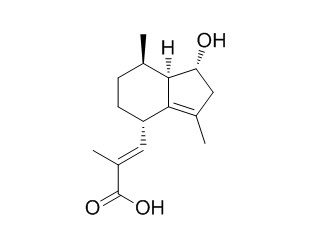Hydroxyvalerenic acid
Hydroalcoholic acid shows affinity for the GABA-A receptor.
Hydroxyvalerenic acid has a low toxicity with IC50 values of 123 and 165 μM against GLC4 and COLO 320 cells, respectively
Inquire / Order:
manager@chemfaces.com
Technical Inquiries:
service@chemfaces.com
Tel:
+86-27-84237783
Fax:
+86-27-84254680
Address:
1 Building, No. 83, CheCheng Rd., Wuhan Economic and Technological Development Zone, Wuhan, Hubei 430056, PRC
Providing storage is as stated on the product vial and the vial is kept tightly sealed, the product can be stored for up to
24 months(2-8C).
Wherever possible, you should prepare and use solutions on the same day. However, if you need to make up stock solutions in advance, we recommend that you store the solution as aliquots in tightly sealed vials at -20C. Generally, these will be useable for up to two weeks. Before use, and prior to opening the vial we recommend that you allow your product to equilibrate to room temperature for at least 1 hour.
Need more advice on solubility, usage and handling? Please email to: service@chemfaces.com
The packaging of the product may have turned upside down during transportation, resulting in the natural compounds adhering to the neck or cap of the vial. take the vial out of its packaging and gently shake to let the compounds fall to the bottom of the vial. for liquid products, centrifuge at 200-500 RPM to gather the liquid at the bottom of the vial. try to avoid loss or contamination during handling.
Foods.2022, 11(6):882.
JLiquid Chromatography & Related Tech.2021, 10826076.
Front Microbiol.2023, 14:921653.
Food Science and Preservation2024, 31(3):486-498.
Int. J. Mol. Sci.2022, 23(8), 4130.
J Nat Med.2017, 71(2):380-388
Evid Based Complement Alternat Med.2018, 2018:8565132
Universitat Stuttgart2022, opus-12200.
Chemical Engineering Journal2024, 500:157110
Mol Med Rep.2022, 26(4):299.
Related and Featured Products
Pharmazie Die, 2003, 58(9):636-638.
In vitro release of valerenic and hydroxyvalerenic acids from valerian tablets.[Reference:
WebLink]
Although most commercial valerian formulations are coated tablets not any comparison study of their drug release profiles has been published so far. The main objective of this work is to establish a drug release test suitable for studying and comparing different valerian tablets.
METHODS AND RESULTS:
Thus, Hydroxyvalerenic acid and valerenic acid concentrations were assayed by HPLC using a C18 Kromasil (200 x 4.6 mm, 5 microm) column and a mobile phase containing methanol and an orthophosphoric acid solution 0.5% v/v in water at a ratio of 75:25 at a constant flow rate of 1 ml/min. Saturation solubilities for Hydroxyvalerenic acid and valerenic acid at pH 6.8 were 26 +/- 5.1 and 1 +/- 0.6 microg/ml, respectively. Usually for drugs with such low solubility values, their oral absorption and hence bioavailability are limited by their dissolution characteristics. A dissolution test was conducted according to the general method 2 (paddles) of USP 24 using 500 ml buffer medium (pH 6.8) at 50 rpm. Five different formulations were studied and compared: one uncoated tablet formulation and four marketed coated tablets.
CONCLUSIONS:
The uncoated tablet formulation had the fastest release profile, whereas the coated tablets manifested very different release patterns, depending on the type of formulation. Because of these differences in drug release pattern not every tablet formulation may be appropriate for the same clinical indications. Clinical data are required to confirm the correlation between drug release pattern and the therapeutically value of each formulation.
Fitoterapia,1993,64(4):291-300.
In vitro study on the interaction of extracts and pure compounds from Valeriana officinalis roots with GABA, benzodiazepine and barbiturate receptors in rat brain.[Reference:
WebLink]
The interaction with GABA-BDZ-Cl receptor complex in rat brain has been investigated in vitro for hydroalcoholic and aqueous extract obtained from the roots of V. officinalis. The affinity of lipophilic and aqueous fraction obtained from the hydroalcoholic extract has also been studied together with that of Hydroxyvalerenic acid and dihydrovaltrate.
METHODS AND RESULTS:
Both hydroalcoholic and the aqueous total extract, as well as the aqueous fraction derived from hydroalcoholic extract showed affinity for the GABA-A receptor. The chemical nature of the compound(s) responsible for such an activity is not correlable with sesquiterpenes or valepotriates. The lipophilic fraction of the hydroalcoholic extract as well as dihydrovaltrate showed affinity for the barbiturate receptor and, even if to a lesser extent, for the peripheral benzodiazepine receptors.
CONCLUSIONS:
The bulk of these evidences indicate that the interaction of unknown constituents, present in total extracts, with GABA-A receptors could represent the molecular base for the sedative effect observed both in man and experimental animals. For the hydroalcoholic extract, a contribute to the sedative effect cannot be excluded due to the interaction of their valepotriate constituents with the allosteric sites of GABA receptors controlling chloride anions influx.



